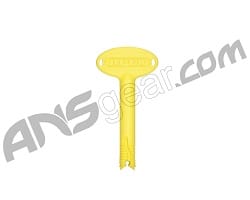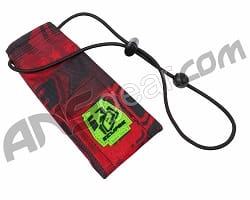Are you ready to head out for your first day of paintball? While the basics of the game are simple… go out and eliminate the opposing team… there are some basic rules and equipment orientation necessary for everyone’s safety and fun. Every established and reputable paintball field will provide a general safety and rules briefing prior to gameplay so this is not intended to replace that. LISTEN TO THE FIELD STAFF’S SAFETY BRIEFING! This article will cover some universal and common sense concepts that need to be adhered to. Other articles will cover paintball equipment in depth but the basic paintball equipment you need is:
- A Paintball Gun, also known as a Paintball Marker.
- A CO2 Tank or Compressed Air Tank.
- A Paintball Hopper, also known as a Loader.
- A Barrel Blocking Device, typically a Barrel cover or a Barrel Plug.
- A certified Paintball Mask, also known as a Paintball Goggle.
1. Your goggles go on and stay on as soon as you step on the field! No exceptions!
The above statement cannot be over-emphasized! The game of paintball involves a lot of projectiles flying through the air and your goggle/ facemask combo is vitally important to keeping your peepers in place. Your goggle and facemask combo features an industry-certified lens and a facemask that covers the cheekbone, nose, mouth and ears. A reputable paintball field will have plenty of signage telling you in no uncertain terms at what point goggles must go on and stay on. Your goggles never come off until you have exited past this point. There are no exceptions, there is no further discussion on this point. YOUR GOGGLES STAY ON YOUR HEAD, PERIOD!


Put your goggles on well before the first game to test for fit and comfort. If it seems uncomfortably tight then loosen the strap a little bit at a time until it is not so tight. Now give your head a few vigorous shakes and nods. Did the mask slip left or right, up or down? If it did, then you’ll need to tighten it up a bit. Most masks come with chinstraps; it is highly recommended to wear it adjust to the proper length. It doesn’t need to be snug against your skin but enough that it won’t slip past your chin and mouth.
Once in game, leave your goggles on no matter what happens. When you get hit and are instructed to leave the field, leave them on. If your goggles fog up and you cannot see, never lift them up for a clear view. Do the best you can and if you simply cannot safely continue then call yourself out, hold your marker in the air and head off the field. If you can’t see enough to get off the field then call for a referee, field staff or teammate to help you. They stay on until you reach the signs telling you that you’re in a safe area and can take them off. If you’re not sure you have reached the safe area you always default to leaving them on. If you see a player take their goggles off, yell at them to put them back on.
While a very rare occurrence, sometimes players fall down and their goggles get knocked off their face, or a tree branch snags the visor and lifts them off. If this occurs to you, immediately drop everything; cover your eyes completely with one hand and drop to the ground, surrounding your face with your other arm. Once on the ground start yelling for a referee or, if the safety briefing was thorough, yell whatever the field staff instructed you to yell (often “blindman” or “goggles”).
2. Use your barrel blocking device!
After goggles the barrel blocking device is the next most important piece of paintball gear. They come in two forms, a plug or a cover. A barrel plug is simply a rubber, plastic or metal with o-rings block that fits snugly into the muzzle end of the paintball marker. A barrel cover (also known as barrel bags, barrel sheaths or barrel condoms) is a tough sewn sheath of material that slips over the muzzle and is secured via a long drawstring pulled over the far end of the marker. The purpose of the barrel blocking device is to ensure that when in place no paintball can leave the muzzle of the marker.




Your barrel plug or barrel cover remains on your marker at all times when you are in a ‘goggles off’ area. The barrel blocking device is there to prevent injury in case of an accidental marker discharge while players are in a safe zone. The only time a barrel cover should ever come off while your marker is pressurized is when you are on the playing field. It doesn’t matter if your marker’s safety catch was on or if you have the muzzle pointed at the ground… MAKE SURE YOUR BARREL BLOCKER IS ON THE MUZZLE WHEN OFF THE PLAYING FIELD!
If using a barrel cover, make sure that it is in good condition and not frayed or tearing. When slipped over the muzzle it needs to be snugly secured around the rear of the marker by its retaining line or strap. If using a barrel plug, make sure that it fits snugly and that both the plug and the barrel are clean of slippery broken paintball fill. Ill fitted barrel plugs in a slick barrel have been known to shoot out of a muzzle with considerable force. For that reason, barrel covers are the preferred muzzle safety system.
3. Treat your paintball marker with respect!
You need to treat a paintball marker with respect to safety. While paintball is a safe sport there is common sense and easy to follow procedures that need to be adhered to.
A) Treat any paintball marker you see as loaded! In other words, always assume that a paintball marker will fire a paintball if the trigger is pulled. Often a player will unload their hopper but a ball is still in the breech or the air tank is removed but a single shot’s worth of air is retained in the regulator.
B) Watch where the muzzle is pointed! The muzzle is the business end of a paintball gun, the end of the barrel where the paintball comes out. Always be aware of which direction it is pointed. The only safe direction a muzzle should be pointed, even with a barrel blocking device in place, is down at the ground or held high and pointed upwards. Even during the middle of a game you should be aware of what direction your muzzle is pointed, as accidentally shooting a teammate is downright irresponsible.
C) Keep your fingers off the trigger until ready to shoot! Most paintball markers have a safety catch that when engaged will prevent the marker from firing. Some do not. Whether or not your particular marker has one and if it’s in use, you always keep your fingers out of the trigger guard area and completely off the trigger until ready to shoot.
D) Chronograph your marker! A reputable paintball field will have a chronograph, which is a device that measures the speed of the paintball. Velocity (speed which the paintball is fired) should be set within safe limits. Follow your instruction manual for the proper procedure to raise or lower your velocity. It is best to set it a bit lower than the field maximum.
Occasionally a paintball breaks in the barrel or breech of the marker. When this happens the marker will be extremely inaccurate and is more likely to continue breaking paintballs. The easiest way to tell is, with finger off the trigger and goggles on in the play area or target practice range, stick your finger in the end of the barrel. If it comes out covered in wet paint fill then you broke a ball at one point. Use a paintball squeegee to clean the barrel.
Sometimes a paintball breaks inside the hopper. The hopper is the storage device you pour paintballs into, that in turn feeds them to the gun. Look inside the hopper and feel around. If it feels a bit greasy that is okay, but if it is wet with paint fill then it needs to be thoroughly cleaned out.
If the distance your marker shoots paintballs is well shorter than everyone else then your velocity is too low. A marker with a low velocity puts you at a severe disadvantage because of the shorter range you can shoot your opponents and that the paintball is more likely to bounce off instead of break when you do hit them. If you think this is the case then go to the chronograph and recheck your marker’s speed.
Again, these are basic universal safety procedures but are no substitute for the paintball field’s safety orientation. An established field will usually have other safety rules particular to their given location or game style. Pay attention and never be afraid to ask the paintball field staff for clarification or more information!